Caring for fiber goats is a fun and profitable way to have a homestead. Not only do they produce high-quality fiber, but they’re also entertaining animals that can provide plenty of laughs.
And let’s not forget how beautiful that fiber is! Not all fiber goats produce cashmere – some produce mohair – but cashmere in particular is a silky material that is known for its fine texture and warm, lightweight feel.
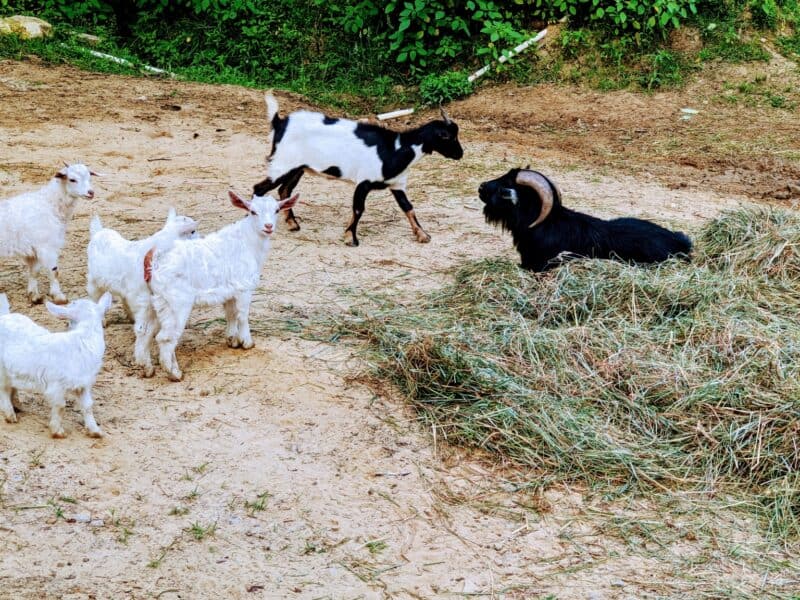
If you’re thinking of adding fiber goats to your farm or homestead, this guide is for you!
In it, you’ll learn everything you need to know about choosing the right breed, caring for them, and harvesting their fiber. So let’s get started!
Table of Contents:
Fiber Goat Breeds
There are four types of fiber goats:
- Angora
- Pygora
- Nigora
- Cashmere
Angora, Pygora, and Nigora goats produce mohair, while cashmere goats produce cashmere.
Difference Between Mohair and Cashmere
Mohair and cashmere are two distinctly different types of luxury fiber used as a textile material.
Cashmere
- The price of cashmere fluctuates depending upon the available supply, but can range anywhere from $120 to $140 per pound.
- The typical Cashmere goat is capable of producing up to six ounces of the silky wool each year. It takes approximately 16 ounces of cashmere to make an adult sweater and just one ounce to make a scarf.
- Cashmere wool is a fiber that is spun from the fleece sheared from the undercoat of a cashmere goat.
- Cashmere goats are not a breed but a type of goat. While all goats are capable of producing cashmere, the goats that are dubbed “cashmeres” and used as a fiber producing animal are exceptional at producing cashmere, and are bred with the goal of furthering both the quantity and quality of this textile material.
- This fiber is known for being lightweight while fostering great warmth to the person wearing a garment comprised of it.
- This type of goat fleece boasts an ultra fine texture. It is soft to the touch yet a strong and durable material.
- Cashmere garments are often deemed to be warmer than the same items made of wool – and more breathable.
Mohair
- The mohair name originated from the Arabic word, “Mukhaya” which means the “cloth of bright lustrous goat hair.”
- Mohair from fiber goats can sell for as much as $10 per pound in its raw state, if the mohair is carded or dyed – or both, the price for the roving increases.
- This kind of goat fleece is also referred to as “the noble fiber” or “diamond fiber” as a reference to its ability to vibrantly reflect color, luster, and overall resilience.
- Mohair is incredibly fluffy and soft. It is often used in spinning, making lace, knitting, weaving, making socks, hats, sweaters, scarves, and gloves.
- Angora mohair does not contain lanolin, like sheep’s wool.
- Goat fleece is more crease and flame retardant that wool.
- Mohair also boasts a more natural elasticity than wool and is more durable.
- Mohair does not have a tendency to become crushed or matted, like wool. This makes goat fleece less desirable for wet or needle felting, but ideal for other types of fiber arts.
- The lightweight structure of mohair allows the body to breathe when garments made of the goat fleece are warm – making it a superb choice for clothing worn in virtually all climates and seasons.
- Mohair can be used alone to make garments or blended with other materials, even tweeds, suit fabric, and knits.
- Goat fleece is being used to an increasing degree as a fake fur used in coat making, garment trim, rugs, doll wigs, and as a natural covering when making stuffed animals.
- When lycra is combined with mohair the elastic material is used to make mohair yarns that better allow garments to be made that retain the ability to move with the body but also hug it to provide a slim silhouette.
- Angora mohair should not be confused with angora wool – which is harvested from Angora rabbits.
Common Mohair Terms
- Fleece – all the mohair harvested from a single shearing.
- Clip – All the mohair from either a single goat for the entire year or all the mohair harvested from the entire herd for a single year.
- First Clip – The mohair sheared during the first shearing – this is usually the softest fleece and is often used in the making of blankets – especially baby blankets and newborn clothing.
- Lock – Mohair fibers that are attached together and dangle away from the Angora, Pygora, or Nigora fiber goat.
- Spinning – The process for transforming mohair into yarn after it has been washed and carded.
- Carding – The process of layering fivers in the same direction to create roving for spinning. Wool or mohair carding brushes are made especially for this purpose but a thrifty homesteader can use a horse brush or dog brush for the Dollar Tree store for the same purpose.
- Staple – This term references the individual mohair strands in a section of fleece that are longer than 4 inches – this length is recommended for spinning.
Mohair is described – or graded, within the fiber industry by using only two words: character and style. The style refers to the twist found within the mohair. Character references the degree of crimp to the mohair.
Spinning wheels can range from the incredibly affordable individual and portable small scale spinner, to medium-sized spinners, to the old-fashioned manual powered, but larger scale spinner.
You do not need to invest in a spinning wheel or even mohair cards to launch a fiber goat homesteading business. You can merely sell the raw mohair or cashmere from your goats and the kids from your breeding stock.
But, learning how to clean, dye, and spin your own goat fleece increases the avenues for potential income, and for making your own fiber art creations to sell.
Angora Goats
Angora goats are perhaps the oldest known goat breed in the world. The use of their mohair as a textile fiber dates at least as far back as the 14th century.
Because a Turkish Sultan banned the export of either Angora goats or their mohair, these magnificent creatures did not appear in the United States until that ban was lifted during the 19th century.
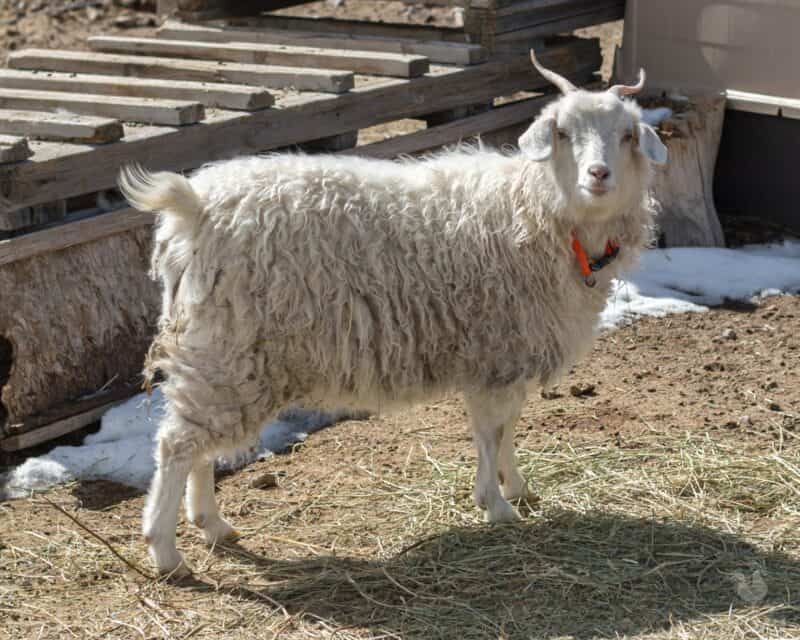
The first Angora goats to arrive in the United States were delivered to South Carolina Doctor James B. Davis. The herd was a thank you gift from the Turkish Sultan for the doctor’s help with cotton cultivation in Turkey.
These fiber goats ahil from Sumeria and Asia Minor. They likely first began being kept as a herd animal between the 12th and the 15th centuries B.C
Angora goat herds were solidly established in the Ankara region of Turkey – where the label “Angora” first became known in reference to this goat breed.
The United States and South Africa are now the two largest producers of mohair around the globe. Small Angora goat populations are still thriving in Turkey, New Zealand, Australia, Great Britain, and Argentina.
Angora Goat Industry
Angora goats, at least the one raised in the United States, have been bred and selected for the white fleece.
Although Angora goats could come in an array of shades, the demands of the textile industry for mohair that can uniformly take dye, dictates the habits of the majority of commercial keepers of this fiber goat breed.
The commercial mohair clippers at the massive fiber warehouses in Texas refuses to work with colored hair, but homesteading and hobby farms still raise Angora goats in any shade they naturally develop.
The growing back to nature and natural products trend has created quite a high-end niche for Angora goats with brown, black, red – and any shade in-between of mohair. Keepers who cater to this niche market typically garner between $10 to $24 a pound for their non-white Angora mohair.
Finding a colored Angora goat is not likely going to be an easy task, and when you do come across one expect to pay between $300 to $600 per head. An Angora goat with a silver goat can fetch an even higher price.
Because there were so few Angora goats were initially available in America, they were often crossbred with any goat a farmer was already keeping, prompting the occasional genetic “throwback” color from popping up in modern commercially bred Angora goats that are white and are only bred with other white goats of the same breed.
All fiber goat breeds should be given a diet that contains 12% to 16% dry matter – such a hay or natural matter inside their pasture – along with a free choice mineral block, to ensure all of their nutrient needs are being met.
Angora Goat Facts
Angora goats weigh between 80 to 250 pounds, but the average non-commercially raised Angora goat weighs in at 150 pounds.
Mature Angora goats stands roughly 36 to 48 inches tall.
Mohair strands on an Angora goat commonly range in length from eight to 11 inches long – when stretched to straighten out the curly fleece. Angora goats are known for their ringlet type hair, which doesn’t grow flat but is instead wavy and bulky.
A mature Angora goat is capable of producing a little more than 5 pounds of mohair during its two annual shearings.
Angora mohair is typically 24 and 25 microns thick.
Unless debudded as kids, the horns on mature male Angora goats are approximately two feet long – or longer. Mature female Angora goat horns tend to measure about 10 inches long. The horns can grow straight or boas a slightly spiral shape.
Because Angora goats spend so much energy growing out their mohair, they are often provided with more natural feeding and grain feed rations that other goat breeds.
These fiber goats breed on a seasonal basis from August through January.
Angora goats are known to be affectionate and docile animals but also thrive when left to independently browse around their pasture or pen.
Because the mohair grows so thickly on Angora goats and can become matted, it is recommended to shear the goats before breeding season to aid the Billy goat’s access to the nanny or doe.
To increase the chances of the doe or nanny producing twins, some Angora keepers increase the feed grain rations and healthy snacks of the prospective momma goats. This process is typically referred to as “flushing” in the goat industry.
Angora goats can throw twins like other goat breeds, but triplets are uncommon, and single births after a first kidding are not unlikely – which is not the norm with most other goat breeds.
Angora nanny goats are prone to remain fertile until they reach the age of 14.
An Angora doe is not considered ready to breed until they hit 60 pounds, which commonly does not occur until they are two years old.
Angora does and nanny goats do not typically suffer from kidding issues which can plague some other goat breeds.
Despite the hardy nature of mature female goats when it comes to fertility and kidding, the newborn kids themselves often become chilled if born in temperatures that hover around 40 degrees F (4 C) or colder.
If a kid born during cold weather does not begin nursing very shortly after being born, the kid may need to be placed under a heat lamp and bottlefed in order to survive.
Planning a breeding cycle so the kids are born in April is recommended for Angora keepers who live in regions without mild winters.
Angora kids are generally deemed to be weaned by the time they are three to four months old.
Angora kids may be more prone to parasite infestations than newborn goats of some other breeds, and should be given a coccidiostat to prevent the potentially deadly coccidiosis medical condition stemming from a parasite infestation, from developing.
Angora goats are often very susceptible to cold and damp weather – possibly making them more prone to contracting goat pneumonia.
This breed is far more likely to develop health problems due to exposure to such weather for up to 6 weeks after shearing.
Placing a “goat coat” onto the animals to protect them from exposure and making sure their stalls are not drafty and have ample straw for them to nuzzle in to stay warm, is highly recommended.
If you’re looking to buy Angora bucks or does, check with your local Angora goat breeders association for more information.
Cashmere Goats
This goat breed has often been heralded as producing the “fiber of kings.” Cashmere goats stem from feral goats initially developed from Spanish and Australian meat goats for their fiber producing traits.
There is no Cashmere “goat breed” but types of selectively bred goats that expertly and abundantly produce the cashmere down beneath the guard hair at the top of their coats.
Cashmere goats exist is all common goat colors but are commercially bred predominantly in white for uniform dying purposes.
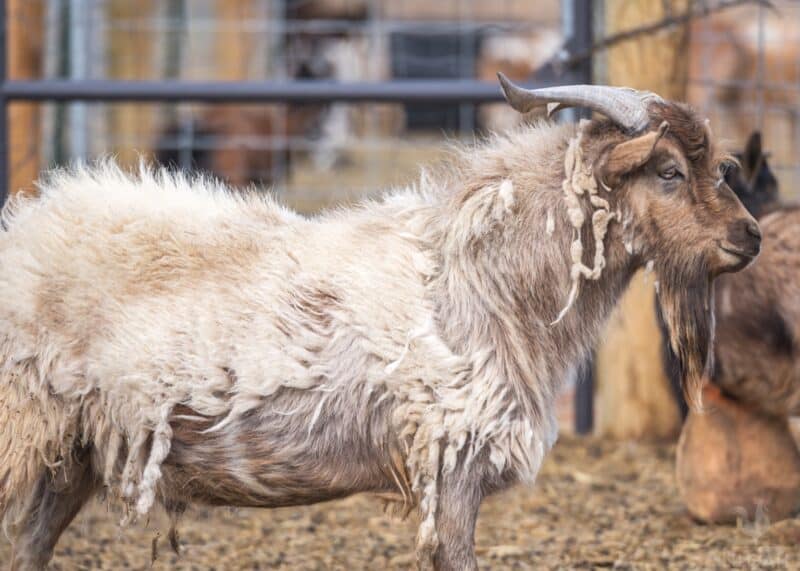
The guard hair on Cashmere goats come in both short and long forms. The guard hair is typically bred to be exceptionally coarse so a mechanical dehairing tool can easily and quickly distinguish it from the monety fiber beneath, the cashmere down.
The fleece on this type of goat is roughly comprised of 60% Cashmere and 40% guard hair.
The quality and likely price of the Cashmere produced by these goats is influenced by three factors: diameter, length, and degree of crimping.
Cashmere fibers are crimped and not wavy, which may be why it is so soft. It is this crimping that permits garments made of cashmere to offer ample warmth without added weight.
The Cashmere industry standards dictate that the fiber strands be a minimum of one and one-fourth inch long with a diameter of 19 microns, on average.
The bulk of the cashmere produced in the world comes from China, where roughly 123 million goats of this type are being raised.
The other nations which follow behind China, but lead the glove in cashmere production (albeit in significantly smaller amounts) include Afghanistan, Iran, Iraq, Turkey, New Zealand, and Australia.
Since the first Cashmere goats were imported to America in the 1990s, a small yet growing number of breeders have been working diligently to bring a larger share of the cashmere market home to the United States.
Cashmere-Producing Goat Breeds
- Australian
- Liaoning
- Changthangi – Kashmir
- Inner Mongolia
- Zhongwei
- Hexi Cashmere Goat
- Zalaa Jinst White goat
- Tibetan Plateau
- Licheng Daqing
- Luliang Black
- Wuzhumuqin
Cashmere Goat Facts
Cashmere goats are exceptionally cold weather hardy. Because they are sheared in the spring, the removal of their thick coats also makes them warm climate hardy, as well.
A mature Cashmere Billy goat is capable of producing as much as two and a half pounds of fleece during the once annual shearing.
Cashmere goats are excellent browsers and can thrive on low quality weeds that even other goat breeds will not eat. It is not unusual for Cashmere goats to eradicate noxious weeds from their grazing areas in a short amount of time – especially poison ivy.
Cashmere goats are primarily raised like all other goat breeds, but because the production of the fleece takes so much energy, they are often considered a more delicate type of goat to keep. They may need more grain and natural food as well as better protection from inclement weather, to thrive.
All types of Cashmere goats are largely known to be independent animals, great foragers, yet boast a calm and docile personality.
Cashmere goats are more susceptible to goat pneumonia than many other goat breeds because their fiber coat is so thick yet does not dry as quickly as either wool or mohair, being exposed to dampness and excess moisture could become deadly.
All fiber goat breeds are typically more susceptible to parasites, especially lice. Practice routine worming and lice prevention year round. Detecting an infestation early can prevent animal illness and loss of either the fiber, the goat – or both.
Cashmere goats (and to a slightly lesser degree, Angora goats) require a protein enriched diet to help them produce a protective and waterproof coating on their fleece. Black sunflower seeds are a healthy and welcomed treat that can help boost protein intake.
Cashmere goats are very easy keepers, and do not typically tend to push their pen boundaries and climb onto objects like many other goat breeds.
Miniature Fiber Goats
Pygora goats are a cross breed of Angora goats and Pygmy goats. Nigora goats are a cross between Nigerian Dwarf goats and Angora goats.
Pygmy and Nigerian Goats
None of the good folks who fell in love with either of these miniature goat breeds when they stepped off the ship from Africa likely envisioned the breeds from ever being bred as a fiber animal.
Both Pygmy goats and Nigerian Dwarf goats arrived in the United States during the 1950s. The miniature goats were destined to become feeder livestock for the large cats they were traveling with from Africa to American zoos.
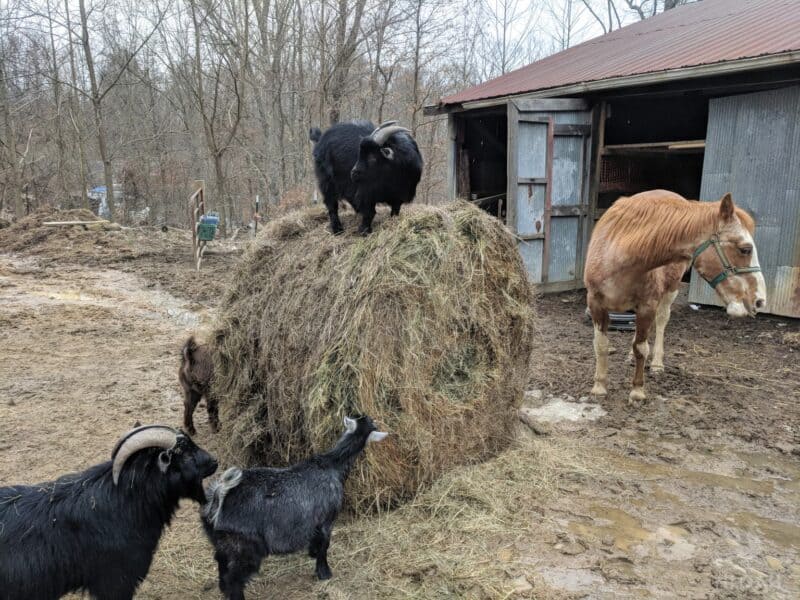
The Pygmy and Nigerian Dwarf goats that survived the journey without becoming a feline entree, found a home at the Gladys Porter Zoo near Brownsville, Texas.
The zookeepers who were among the first Americans to ever witness the romping and frollicking antics of the miniature goats, worked out a deal with the big cat delivery guys to allow them to remain at the zoo. The small goats were placed in the petting zoo, and became an extremely popular attraction.
It was not until the miniature young goats matured that the Texas zoo staff noticed the slight differences between the animals, and determined them to be of different breeds.
Two local women who were seasoned livestock keepers were each awarded some of the miniature goats – of different breeds.
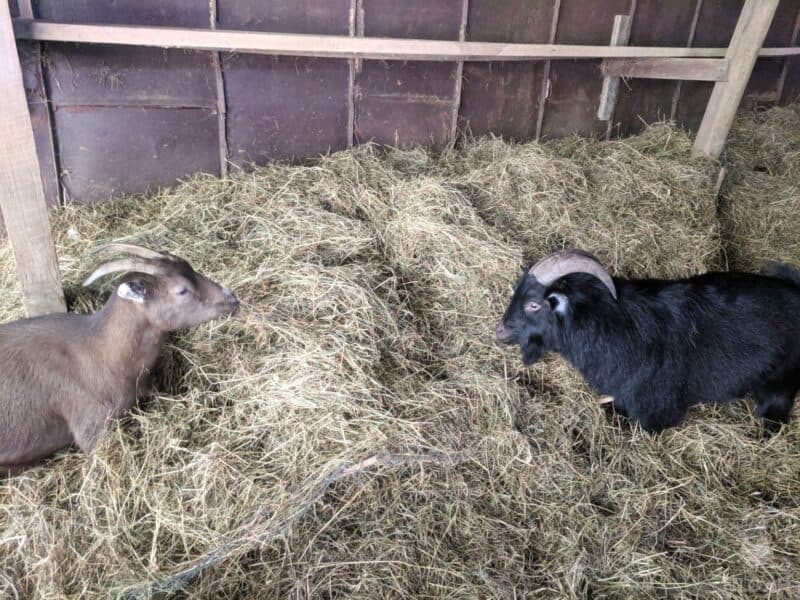
The Pygmy goats were raised and bred as meat goats, and the Nigerian Dwarf goats were bred and kept as a quality milking goat breed.
The National Pygmy Goat Association is an excellent resource for more information on this breed.
Pygora Goats
This fiber goat breed produces a miniature goat that is about the same size as a blue heeler farm dog. Pygora goats were created by cross breeding Pygmy goats and Angora goats in Oregon during the 1980s.
Katharine Jorgensen, a 4-H Pygmy goat judge and herd keeper, became enamored with the strikingly beautiful colors of mohair used in fiber arts and textiles on a Native American reservation she visited in the Southwest.
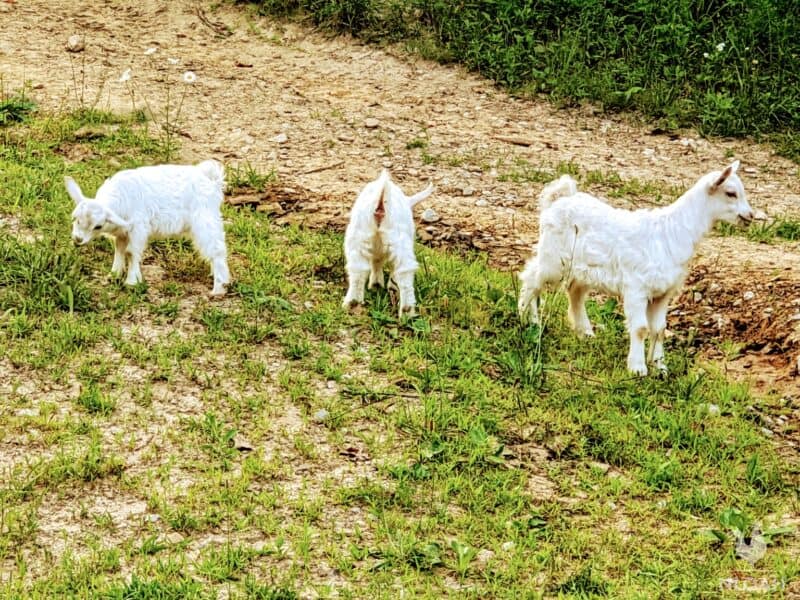
Jorgensen was inspired to use the Pygmy goats she was already to cross with Angora goats to develop a miniature fiber goat breed.
The Oregon City goat keeper began this exciting first generation of goats using a Pygmy goat that was registered with the NPGA and an Angora goat registered with the AAGBA.
In 1987, the Pygora Breeders Association was founded to promote and record the lineage of the Pygora breed of goats.
Pygora Goat Facts
- A miniature fiber goat of this technically a dual purpose goats because it does produce a quality meat but is almost strictly raised for its mohair. They are often referred to as “Miniature Angora Goats”.
- Pygora goat mohair can be easily dyed to obtain a vibrant color from any shade of the rainbow. But, their coats naturally comes in black, white, brown, gray, caramel – and a mixture of those colors, instead of the traditional white of their Angora ancestors.
- A mature Pygora goat grows to heights of roughly 18 to 24 inches tall (45 cm to 61 cm).
- Mature Billy goats of this miniature fiber goat breed weigh between 75 to 94 pounds (34 kgs to 42 kgs) on average.
- Mature does or nanny goats weight between 63 to 75 pounds (28 kgs to 34 kgs), on average.
- The typical lifespan of a Pygora goat is between 12 to 15 years.
- The mohair on Pygora and Angora goats remains soft and fluffy as they age, making the keeping of senior goats of these breeds still a solid fiber producing endeavor.
- Pygora goats typically give birth to a single kid during their first pregnancy and twins, sometimes even two sets of twins, in following kiddings.
- These cute little fluff balls are as energetic, curious, and social as the Pygmy goats they garner half of their DNA from.
- Like their Angora ancestors, Pygora goats are also incredible docile in general and especially during shearing.
- Newborn kids of this breed weigh only two or three pounds when they are born. The kids stand and nurse almost immediately after being born.
- Pygora kids are generally deemed to be weaned when they are three to sometimes four, months old. The kids transition from yearling into mature miniature fiber goats when they are eight to 12 months old – earlier than their Pygmy ancestors.
Nigora Goats
This miniature fiber goat breed is a cross between Nigerian Dwarf small stature goats and Angora goats. The Nigora goat was created in America as a dual purpose fiber and milk breed in 1990.
A breed association for Nigora goats was not established until 2007 and is known as the American Nigora Goat Breeders Association. In 2014, a second organization was formed to further this miniature fiber goat breed, the Nigora Goat Breeders Society.
Initially, Nigerian Dwarf Billy goats of any color were bred with only white Angora nanny or does. Now, it is not uncommon for Nigerian Dwarf goats to be bred with Angora females of any color to create these miniature fiber goats.
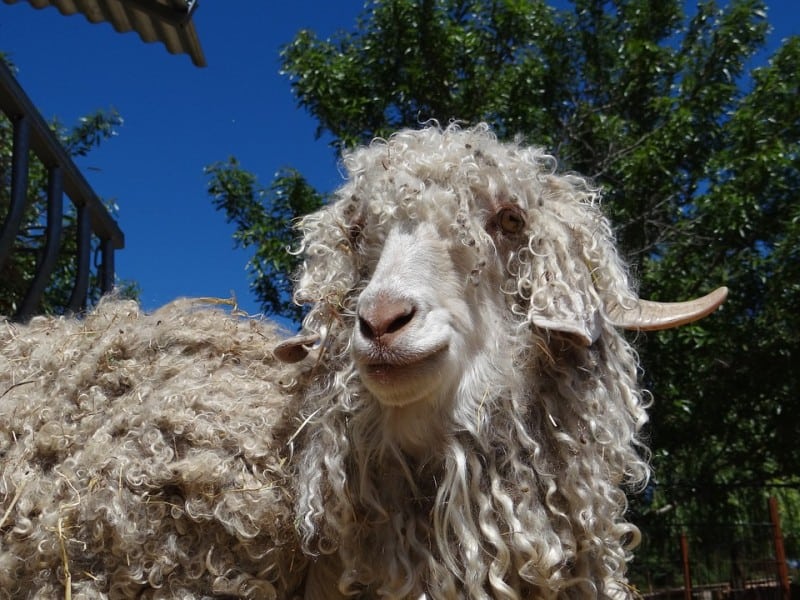
Nigora Goat Facts
- Mature Nigora goats of either gender stand approximately 19 to 24 inches (45 to 61 cm) tall.
- Like their Nigerian Dwarf and Angora ancestors, members of the Nigora goat breed are docile, smart, and relatively affectionate with their keepers.
- Although raised primarily for their mohair, Nigora goats are also often kept as farm pets and 4-H breeding and fiber goat project animals.
- Nigora goats typically produce a type of goat fleece known as “cashgora.” This style of a goat coat is comprised of three distinct types of fiber known as “Type B” which is a mixture of mohair and cashmere. The other two types of fiber a goat produces are “Type A” which is mohair, and “Type C” which is cashmere.
- These goats are hardy in nearly all climates, but like other fiber goats are susceptible to parasite infestations and contracting goat pneumonia when exposed to cold or damp surroundings. They too should be nestled in a goat coat after shearing and their stalls reviewed for signs of draft and extra straw added to keep them warm and dry.
- Nigora kids weigh about two to three pounds when they are born, and progress in activity and maturity at the same rate as Pygora goat kids.
- Mature goats of this breed weigh 40 to 85 (18 to 38 kgs) pounds on average.
- Nigora goats are often classified as being either “light” and more like a Nigerian Dwarf goat in size, or “heavy” and carry more of their Angora DNA.
Can You Raise a Dairy Goat or Meat Goat as a Fiber Goat?
Most people who raise goats do so for either dairy or meat production. However, there is a third option: fiber goats.
Fiber goats are breeds that are known for their high-quality wool or hair, which can be used for a variety of purposes. While any goat can technically be raised for fiber, certain breeds are better suited to this purpose than others.
Therefore, you should avoid raising goats that aren’t specifically designed for this purpose (like Boer goats and many other Spanish goats that are typically raised for meat or dairy) and try to find fiber goats instead.
Fiber Goat Shearing Tips
Delous the fiber goat herd a few weeks before the shearing is scheduled to rid the animals of parasites.
Never shear a wet goat, the fiber will become matted in the shears, and almost always cause undue pain and possible cuts by the tool on the goat’s flesh. It is best to ensure the goats have been dry for a full 24 hours before shearing.
Begin the shearing with the kids and then work your way up in age to the older members of the herd. This process allows you to separate first clip mohair or cashmere from the rest of the fleece.
This is a wise way to separate and process the fiber because the super soft fleece from the kids always brings the highest value.
Shear youngest goats first and oldest goats last to prevent coarser fiber from becoming mixed with finer, higher-value hair.
Prepare a fiber goat for shearing by washing them AND blowing away as much dirt and debris as possible.
Use a hair dryer on a cool setting or an air compressor with a fine nozzle to do the blow dry portion of the preparation.
Always blow along the side of the goat’s fleece and not straight down; doing so will push the gunk you are trying to remove further into the mohair or cashmere, and create tangles in the process.
Shear just one single stripfrom the along the backbone or the fiber goats up towards the withers.
Next, continue the shearing on either side of the backbone but this time down the sides of the fiber goat. Keep the blades of the shearing tool parallel to avoid nicking the animal’s skin.
During the shearing of the underbelly of the goat, take special care not to come too close to the penis, teats, udders, or testicles. Shear slowly and gently in this area, make sure you have good light, and that your view is not obscured during the process.
When shearing the mohair or cashmere around the hind legs, special care must be taken again to avoid nicking the back leg tendon.
During the shearing of the neck and chest area, pay close attention if the goat has wattles. Do not shear them, but slowly and gently maneuver around them, instead.
Shear the shoulder area of the fiber goat up and down and not across to prevent hitting the flesh that runs in-between bones, or the bones.
It is best not to shear during the later fall through the early spring, but if you do, always leave the fiber goat a light layer of its mohair or cashmere to protect it from the elements.
A goat coat should still be worn for at least four weeks when shearing during the cold weather or during an unseasonably cold period.
Carefully inspect the goat’s entire body in search of cuts large or small. Any wounds from shearing should be treated with antiseptic ointment,s and perhaps even a spray covering of Blu-Kote. Even untreated minor lacerations could lead to a deadly infection.
When selling mohair or cashmere, the goat fiber will not bring as high of a return if it has bits of debris or chaff in it. The fiber is graded by buyers, and discerning ones will not purchase raw fiber that is mediocre in texture or deemed unclean.
Since the animals will already be temporarily immobilized in a shearing stand, and free from their thick covering, shearing time is also a good time to given any annual vaccinations.
Other Care Required for Fiber Goats (Besides Shearing)
When you picture a fiber goat, you might think of a shaggy, unkempt animal. But the truth is, these animals require a surprising amount of care. From shearing to housing to diet, there are a few things you need to keep in mind if you’re thinking of adding a fiber goat to your farm.
Housing
Fiber goats should have access to shelter that protects them from the elements. This can be anything from a simple three-sided shed to a more elaborate barn. It’s important that the goat has access to fresh, clean water at all times.
Diet
A well-balanced diet is essential for fiber goats. They should have access to hay, pasture, and a limited amount of grain. They also require minerals and salt blocks for optimal health.
Trimming Hooves
Fiber goats, like all goats, need their hooves trimmed on a regular basis. If left untrimmed, hooves can become overgrown and cause a number of problems for goats, including pain and difficulty walking. Depending on the size and condition of your goat’s hooves, they may need to be trimmed every 4-8 weeks.
Vaccinations
Fiber goats also need to be vaccinated against a number of diseases, including rabies, tetanus, and enterotoxemia. Vaccinating your goats will help keep them healthy and protect them from diseases that could potentially be fatal.
Brushing
Goats should also be brushed regularly to prevent matting and keep their coat healthy.
Starting a Fiber Goat Business
Start small. That little bit of advice cannot be emphasized enough – especially if you are going to be shearing your own goats. One Billy goat and three does is a large enough herd for any new fiber goat breeder.
Once you have an idea of the feed costs of the herd as well as how long it will take to routinely wash the fiber goats as well as prepare them for shearing and complete the process. Only then is it time to enhance herd numbers.
The start-up costs to purchase fiber goats, multiple goat coats, shearing tools, and any mohair or cashmere processing supplies also need to be factored into the new homesteading side hustle.
How much you will have to spend on the purchase of fiber goats will vary heavily based upon the breed, age, and location of the animals you wish to purchase.
Expect to pay more for a fiber goat due to their still small herd numbers in most parts of the United States, than you would a quality milk or meat goat breed readily available in your area.
When you start a homesteading business of any type, you move from being what the federal government deems a “hobby farm” to a commercial operatoin – regardless of the size of the new business. This can be a really good thing from an income tax perspective.
Yes, you will need to report income from the new business, but you can also claim all expenses related to the fiber goat business.
Common Farm Business Allowable Tax Deductions:
- Animal Cost
- Feed Cost
- Veterinary expenses
- Shearing tools
- Milking or Shearing Stand
- Hay Cost
- Straw Expenses
- Mileage for any business related driving
- Farm Equipment
- ATV Equipment
- Farm Equipment and ATV Fuel Expenses
- A portion of utility bills for electricity, water, generator fuel, or solar panels used in the care of the animals and to power the home office.
- A home office space tax deduction.
- Internet and cellphone bills if they were used for business operations
- Website creation and maintenance related expenses
- Special clothing needed for business operations – muck boots, work gloves, etc.
- Mohair and Cashmere carding equipment
- Fiber Spinning Wheel
- Fiber Dyes
- Marketing Expenses
- Association memberships
- Goat show registration related expenses
- Goat halters and lead straps
- Goat Coats
- Goat feeders and waterers
This is just a brief overview of some of the farming business related expenses of which I am familiar. I am not a tax professional of any type, but I highly advise you work with one when setting up the homesteading business.
He or she can guide you through the necessary record keeping process you should engage in to provide proof of expenses as well as other key tips that can help you properly document the fiber goat homesteading business – and hopefully help you save money in the process.
Joining a goat association, fiber artists organization, or homesteading can help you learn more about industry trends, supply and demand, and to connect with potential buyers.
Oftentimes, belonging to such groups offers more than knowledge sharing for newbies and marketing opportunities.
Being a member of a goat or fiber arts club (that meets either virtually or in person), can foster a sense of community that can help bolster your spirits, and celebrate your victories as you journey towards creating a successful homesteading based business.
FAQ
Angora goats are perhaps the best known for their fiber, which is used to make angora wool. Angora fiber is extremely soft and fine, making it ideal for spinning into yarn. Angora goats are also relatively easy to care for, which makes them a popular choice for small farmers and hobbyists.
Fiber goats can be profitable for farmers and ranchers who are looking for an alternative to traditional livestock. There are many benefits to raising fiber goats, including the fact that they require less land and feed than other types of animals.
When it comes to stocking density, there are some guidelines that should be followed. In general, you can have up to four adult Angora goats per acre of land. If you are keeping kids or wethers (castrated males), you can have up to eight per acre.
Goat fibers are most commonly used for making clothing and textiles. The fiber is lightweight and breathable, making it ideal for warm-weather apparel. It is also strong and durable, making it a good choice for garments that will see a lot of wear and tear.
In addition to clothing, goat fiber can also be used for making ropes, blankets, and other textile products.
While Angora goats are not typically consumed as food, there are some cultures in which they are eaten. However, the majority of people who raise Angora goats do not do so for the purpose of eating them.
Growth rate is largely determined by genetics, and individual goats within a breed can vary widely in this respect. That said, there are some breeds that tend to grow faster than others.
For example, the Boer goat is a popular breed that is known for its rapid growth. Other fast-growing breeds include the Alpine, LaMancha, and Nubian goats.
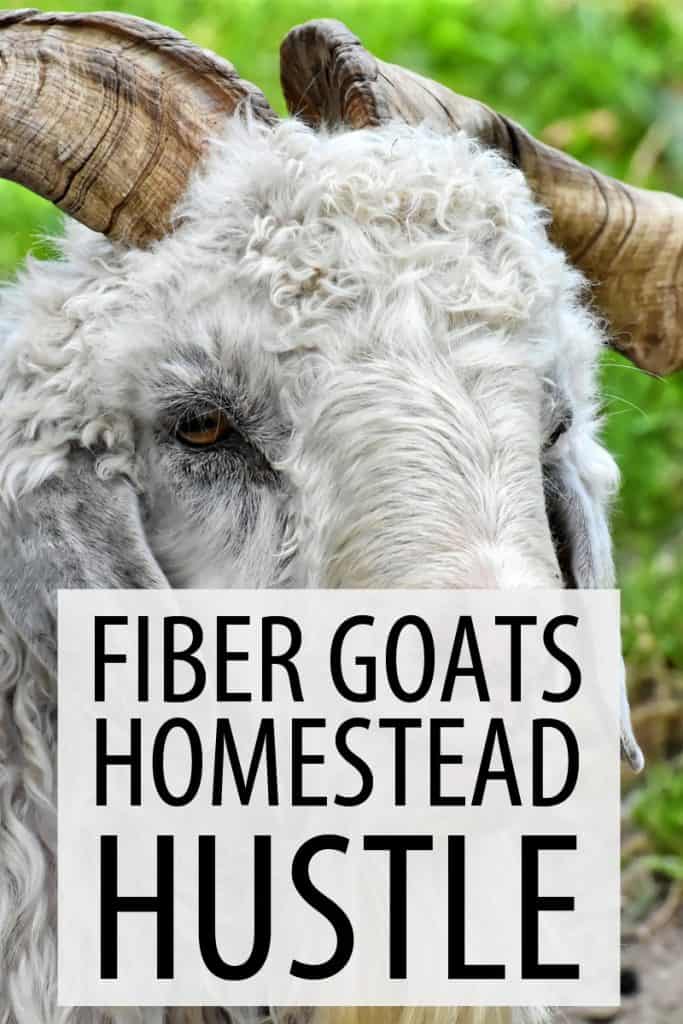

Tara lives on a 56 acres farm in the Appalachian Mountains, where she faces homesteading and farming challenges every single day, raising chickens, goats, horses, and tons of vegetables. She’s an expert in all sorts of homesteading skills such as hide tanning, doll making, tree tapping, and many more.
